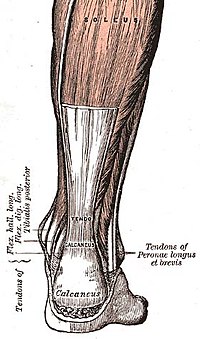
Photo from wikipedia
Background Both percutaneous Achilles tendon lengthening by triple hemisection and the traditional open Z-lengthening are effective methods for Achilles tendon contracture. This study aims to evaluate the efficacy and safety… Click to show full abstract
Background Both percutaneous Achilles tendon lengthening by triple hemisection and the traditional open Z-lengthening are effective methods for Achilles tendon contracture. This study aims to evaluate the efficacy and safety of this new therapeutic method, which is based on the percutaneous sliding technique with three hemi-cuts in the tendon, as compared with the traditional open Z-lengthening. Methods Retrospective analysis of the Achilles tendon contracture cases in our hospital between January 2010 and September 2016 was conducted. Twenty-five cases received percutaneous Achilles tendon lengthening (group A), and 30 patients who underwent open Z-lengthening during the same period were in the control group (group B). Operative time and hospital stay were statistically analyzed. Incision complication, equinus recurrence rate and Achilles tendon rupture morbidity were recorded. The function was assessed by American Orthopaedic Foot & Ankle Society (AOFAS) score. All cases in group A received Magnetic Resonance Imaging (MRI) of ankle preoperatively and in the follow-ups. Results The mean follow-up period was 42.04 months in group A and 61.7 months in group B. The entire operative time and the mean hospitalization days were lower in group A than in group B. No incision and infection complication occurred in group A. The infection rate in group B was 3.3%. Equinus recurrence rate was 4% in group A and the equinus recurrence rate in group B was 21.4%. In group A, the mean AOFAS score increased from 64 ± 10.16 points preoperatively to 96.08 ± 3.17 at final follow-up, while the score in group B increased from 63.48 ± 6.2 points to 85.4 ± 10.3. MRI showed continuity of the Achilles tendon and homogeneous signal in group A. Conclusion Modified surgery can significantly reduce the risk of Achilles tendon rupture, provide better balance in soft tissue strength between ankle dorsiflexion and ankle plantarflexion, helping to avoid recurrence of the deformity.
Journal Title: BioMed Research International
Year Published: 2019
Link to full text (if available)
Share on Social Media: Sign Up to like & get
recommendations!